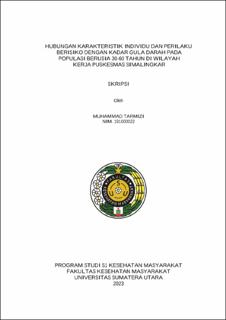Hubungan Karakteristik Individu dan Perilaku Berisiko dengan Kadar Gula Darah pada Populasi Berusia 30-60 Tahun di Wilayah Kerja Puskesmas Simalingkar

Date
2023Author
Tarmizi, Muhammad
Advisor(s)
Siregar, Fazidah Aguslina
Metadata
Show full item recordAbstract
The World Health Organization (WHO) predicts a global increase in type 2 diabetes mellitus. Indonesia currently ranks among the top 10 countries in Southeast Asia with 10.7 million diabetes cases. This study aims to examine the relationship between individual characteristics and risky behaviors with blood glucose levels in the population aged 30-60 years in the working area of Simalingkar Community Health Center. This type of research is quantitative analytic with a cross-sectional design. The population in this study were all residents aged 30-60 years in the working area of Simalingkar Community Health Center. The sample size consisted of 120 respondents selected through accidental sampling. Data was collected through interviews using questionnaires and physical activity level forms, along with measurements of blood glucose levels, waist circumference, height, and weight. The results of this study based on individual characteristics showed that abnormal blood glucose levels were most prevalent in individuals aged over 45 years as much as 58.2 percent, had an excess body mass index of as much as 54.7 percent, and at-risk waist circumference of as much as 63.2 percent in males and 52.7 percent in females, while based on risky behaviors, most were prevalent in individuals with insufficient physical activity as much as 51.2 percent, excessive consumption of sweet foods and drinks as much as 63.3 percent, and smoking as much as 50.0 percent. The results also showed that variables related to blood glucose levels are age (p=0.000), body mass index (p=0.013), waist circumference in males (p=0.043) and females (p=0.012) , physical activity (p=0.022), and consumption of sweet foods and drinks (p=0.000) while smoking (p=0.520) is not related to blood glucose levels. It is expected that the community will do at least 150 minutes of regular physical activity per week with easy-to-accomplish forms of physical activity and reduce the consumption of sweet foods and drinks.
Collections
- Undergraduate Theses [3186]
